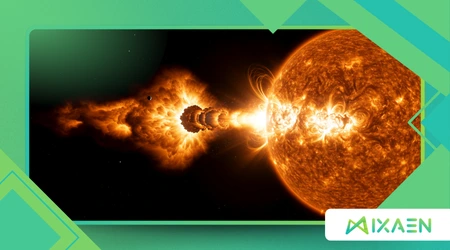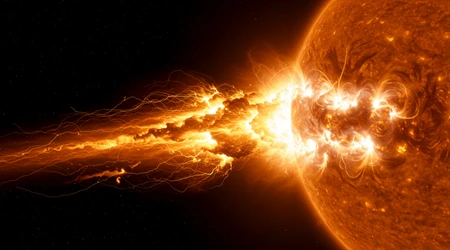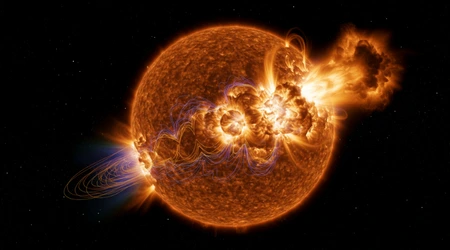What We Still Don’t Understand About Solar Flares

Solar flares captivate scientists and skywatchers alike, erupting with energy that dwarfs humanity’s most powerful explosions.
Anúncios
These bursts of radiation from the Sun’s surface, tied to its magnetic field, spark awe and curiosity. Yet, despite decades of study, mysteries persist about their triggers, impacts, and predictability.
Why do these cosmic events elude full understanding in 2025? This blog dives into the unknowns, blending cutting-edge research with practical insights.
From their erratic behavior to their effects on Earth, we’ll explore what keeps solar flares enigmatic, offering a fresh perspective on this stellar phenomenon.
The Elusive Triggers of Solar Flares
Pinpointing what sparks solar flares remains a scientific puzzle. Magnetic reconnection, where twisted field lines snap, drives these outbursts.
But why some regions ignite while others don’t baffles researchers. Complex magnetic structures evolve rapidly, defying simple models.
NASA’s Solar Dynamics Observatory (SDO) reveals flickering loops signaling impending flares, yet no universal trigger pattern exists.
The Sun’s magnetic field behaves like a tangled rubber band, storing energy until it breaks. But the breaking point varies unpredictably.
Small-scale plasma movements may hold clues, but current instruments struggle to capture them. High-resolution telescopes, like the Daniel K.
++ How Solar Energy Powers the Heliosphere: Unraveling the Sun’s Cosmic Influence
Inouye Solar Telescope, offer hope but not answers yet. The trigger’s randomness keeps forecasts uncertain.
Imagine a pot of boiling water bubbles form erratically despite steady heat. Similarly, solar flares emerge from chaotic magnetic churns.
Scientists hypothesize nanoflares, tiny bursts, might prime larger events. But detecting these micro-events demands technology beyond today’s reach, leaving triggers shrouded in mystery.

Why Prediction Remains a Challenge
Forecasting solar flares is like predicting a storm with half the radar data. Machine learning models, trained on SDO data, improve accuracy but falter with rare, massive flares.
The Sun’s 11-year cycle offers context, but flare timing defies strict schedules. Prediction gaps endanger satellites and power grids.
In 2025, NOAA’s Space Weather Prediction Center achieves 70% accuracy for moderate flares but struggles with X-class events.
These high-energy outbursts, though rare, cause the most damage. Limited data on extreme events hampers algorithms. Real-time monitoring helps, but it’s not foolproof.
Also read: What Causes the Sun’s Differential Rotation? Unraveling the Star’s Dynamic Spin
Consider a game of cosmic roulette solar flares are the wild card. Researchers at Stanford University use AI to analyze magnetic field data, yet false positives persist.
A 2024 study found only 50% of X-class flare predictions were correct. Improved computing power may bridge this gap, but not soon.
The unpredictability stems from the Sun’s dynamic interior. Convection currents, invisible to us, twist magnetic fields in unseen ways.
Analogous to earthquakes, flares release stored energy, but their “fault lines” are harder to map. Until we probe deeper, forecasts will remain imperfect.
Impacts on Earth: Knowns and Unknowns
Solar flares unleash radiation that can disrupt Earth’s technology. Radio blackouts and GPS errors are well-documented effects. But their long-term impact on infrastructure remains unclear.
Satellites face increased drag, but quantifying risks is tricky. Power grids are vulnerable, yet data is sparse.
The 1989 Quebec blackout, caused by a flare-induced geomagnetic storm, is a stark example. Transformers overheated, leaving millions without power.
Modern grids are more resilient, but a 2023 NASA report warns of gaps in protection. Extreme flares could cost billions.
Read more: The Sun as a Laboratory for Studying Plasma Physic
Picture a digital tightrope solar flares threaten to knock systems off balance. Aviation faces risks, too; polar flights reroute during flare events to avoid radiation.
But how much exposure is too much? Studies on astronaut safety offer clues, but terrestrial impacts need more research.
Economic consequences are another blind spot. A 2022 study estimated a severe flare could disrupt global supply chains for months.
Yet, precise models for cascading failures are lacking. As reliance on tech grows, understanding these ripple effects becomes urgent.
The Role of Solar Flares in Space Weather
Space weather, driven by solar flares, shapes our cosmic environment. Coronal mass ejections (CMEs), often linked to flares, hurl charged particles toward Earth.
These can trigger auroras or damage spacecraft. But the flare-CME connection isn’t always clear. Some flares lack CMEs why?
Data from ESA’s Solar Orbiter shows 30% of flares produce no CMEs. This inconsistency complicates space weather models.
CMEs amplify flare impacts, but their absence doesn’t guarantee safety. Radiation from flares alone can harm satellites.
Think of solar flares as a cosmic orchestra sometimes they play solo, sometimes with CMEs as backup. This variability challenges mission planners.
For example, SpaceX’s Starlink satellites faced outages during a 2024 flare event. Better models could mitigate such risks.
The Sun’s activity peak in 2025 heightens space weather concerns. Flares are more frequent, but their intensity varies.
Researchers struggle to predict which events will disrupt Earth most. Advanced probes, like NASA’s Parker Solar Probe, aim to clarify these dynamics.
New Frontiers in Solar Flare Research

Unraveling solar flares demands innovative tools. Next-generation telescopes, like ESA’s Vigil mission, launching in 2027, will monitor the Sun in real time.
These platforms aim to capture finer magnetic details. But until then, gaps in data persist. Technology drives progress, slowly.
AI is transforming flare research. A 2025 algorithm from MIT analyzes SDO images, spotting patterns humans miss. Yet, it’s not perfect rare events still slip through.
Combining AI with ground-based observatories could revolutionize understanding. Collaboration is key.
Visualize a detective piecing together a cosmic crime scene solar flares leave clues in magnetic loops.
The Inouye Telescope’s 2024 images revealed unprecedented detail, but interpretation lags. Training scientists to decode these visuals will take years. Patience is essential.
Citizen science offers a fresh angle. Projects like Zooniverse engage amateurs in classifying flare data. Their insights, paired with AI, accelerate discoveries.
This democratization of science could unlock new perspectives on solar flares, fostering global curiosity.
Table: Key Solar Flare Impacts on Earth (2025 Data)
| Impact | Description | Example Event | Estimated Cost |
|---|---|---|---|
| Radio Blackouts | Disrupts HF radio communication | 2024 X-class flare | $10M/day |
| Satellite Damage | Radiation degrades solar panels | Starlink 2024 outage | $50M |
| Power Grid Disruption | Geomagnetic storms overload transformers | 1989 Quebec blackout | $2B (adjusted) |
| Aviation Rerouting | Polar flights avoid radiation exposure | 2023 M-class flare | $1M/flight |
Engaging the Public: Why Solar Flares Matter
Why should you care about solar flares? Beyond science, they touch daily life. Your phone’s GPS, your flight’s safety, even your power bill flares influence them all.
Public awareness lags, but education can bridge this gap. Knowledge empowers preparedness.
In 2025, NASA’s “Sun Trek” campaign uses VR to simulate flare impacts. Schools adopt it, sparking student interest. But broader outreach is needed.
Media often sensationalizes flares, muddying facts. Clear communication is crucial.
Imagine explaining solar flares to a child like fireworks in space, they’re beautiful but risky. Simplifying without dumbing down engages audiences. A 2024 survey showed 60% of Americans don’t understand space weather. Education must evolve.
Social media amplifies outreach. X posts from @NASASun share real-time flare updates, demystifying science. But misinformation spreads fast.
Scientists must counter myths with facts, using relatable stories. Public engagement fuels funding and progress.
Conclusion: Embracing the Mystery of Solar Flares
Solar flares remain one of nature’s grand enigmas, blending beauty with unpredictability. In 2025, we’ve glimpsed their triggers, impacts, and patterns, but full mastery eludes us.
From magnetic chaos to space weather risks, these bursts challenge science and society. Advances in AI, telescopes, and public outreach offer hope, yet patience is required.
By embracing the unknown, we fuel curiosity and resilience. Let’s keep watching the Sun, ready for its next dazzling, dangerous display. What will solar flares teach us tomorrow?
Frequently Asked Questions
Q: How often do solar flares occur?
A: Solar flares vary with the Sun’s 11-year cycle. During the 2025 peak, dozens can occur weekly, but X-class flares are rare, happening a few times yearly.
Q: Can solar flares harm humans directly?
A: No, solar flares don’t harm humans on Earth due to our atmosphere’s protection. But astronauts and high-altitude pilots face radiation risks.
